Constantine VII, 913-959, replaces Romanus I. A Byzantine story illustrated by Byzantine copper coins.
Byzantine history is, well, Byzantine. The complicated reign of Constantine VII, Porphyrogenitus, illustrates it. "Porphyrogenitus" means "born in the purple," which means his father (Leo VI, 886-912) was emperor when he was born. Unfortunately, when his father died Constantine was only seven or eight--too young to rule. Leo's brother, Alexander, (912-913) took the throne and sidelined both Constantine and his mother, Zoe, who Alexander sent to a convent. But Alexander died after only a year and Constantine became nominal ruler with regents. Regents tend to like power for themselves, so it gets complicated. The principal players are the young Constantine VII, his mother, Zoe, the patriarch of Constantinople [the first head of the council of regents], and Romanus I, a military man who became regent and co-emperor. There are more twists and turns than I recount here, but some events are illustrated by the third coin below which is clearly overstruck. (I posted the first version of this web page on CoinTalk, April 23, 2019.)
What's new? 2024, October 31: A silver miliaresion of the period when Romanus was in charge and his sons Stephan and Constantine were third and fourth in line behind Constantine VII who was second.
2023, June 21: A scarce type of Constantine VII alone before the coins of Romanus.
2022, July 12: A short paragraph on Romanus II, son of Constantine VII.
Here are examples of the most common types for Constantine VII and for Romanus.
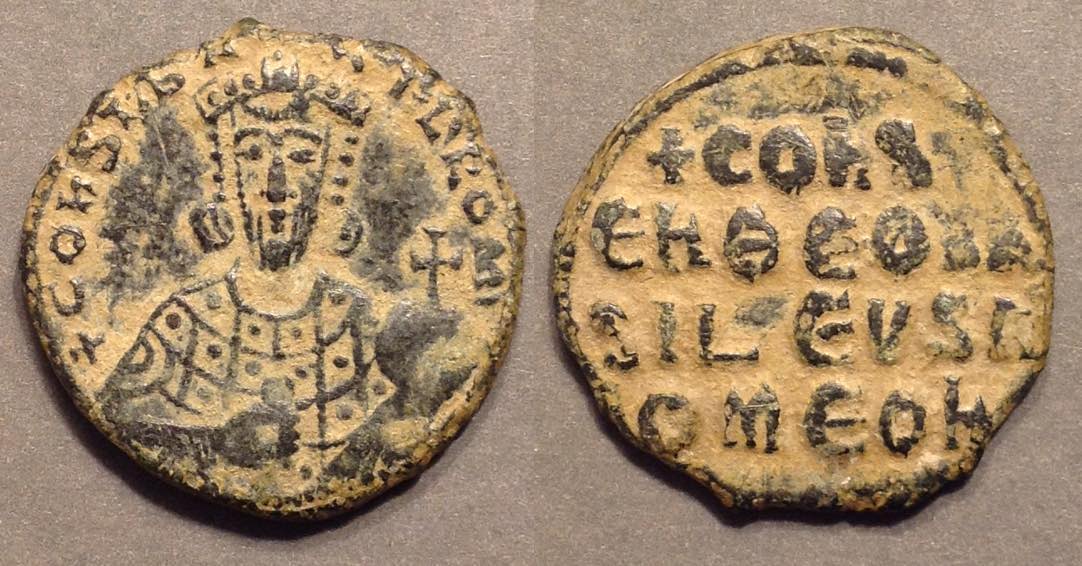 Constantine VII, 913-959
Constantine VII, 913-959
Struck 945-c. 950 (i.e. very late in the time period given for his reign)
26 mm. 6.77 grams.
Facing bust of Constantine VII, holding globus cruciger in left hand and akakia in front of his chest in his right hand.
+COҺST bA - SIL ROM' around ["N" looks like "Һ" on these coins]
"Constantine, emperor of the Romans"
Four line reverse legend:
+COҺST/ЄҺ ΘЄO bA/SILЄVSR/OMЄOҺ
"Constantine, in God (by the grace of God), ruler of the Romans"
Sear 1761.
DOC Constantine VII 26 "945-c. 950" ("Class 5")
[All references to the Dumbarton Oaks Catalogs are to volume 3, part 2.]
The type above of Constantine VII is almost always poorly overstruck, usually on coins of Romanus (next) which were removed from circulation.
 Romanus I, 920-944, during the reign of Constantine VII (913-959), but with no mention of Constantine VII. Struck 931-944.
Romanus I, 920-944, during the reign of Constantine VII (913-959), but with no mention of Constantine VII. Struck 931-944.
27 mm. 6.95 grams.
Obverse legend: + RWMAҺ BASILEVS RωM'
"Romanus, emperor of the Romans"
The face is not as long as the face of Constantine VII.
The legends--both obverse and reverse--are of Romanus.Reverse: +RWMA/Һ' EN ΘEω bA/SILEVS Rω/MAIωҺ
"Romanus, in God (by the grace) of God, ruler of the Romans"
Sear 1760.
DOC Constantine VII 25, "931-944" ("Class 4")
If you collect one coin of each emperor, these are the types you would be most likely to find. The dates have the type of Romanus struck before the type of Constantine VII, even though Constantine VII was emperor first. How can that be? How can we know?
Byzantine types are often put in order using overstrikes. The undertype must be earlier. This example puts the two types above in chronological order.
 This coin: 27 mm. 6.14 grams.
This coin: 27 mm. 6.14 grams.
The overtype is of Constantine VII, the type of the first coin above. This example is clearly overstruck. There is bold lettering of the undertype slanting steeply upwards in the upper right quadrant of the obverse. The undertype is the reverse type of the Romanus I coin above. The red parts of the Romanus undertype are clear:
Һ' EN ΘEω bA (at 12:30)
SILEVS Rω (up toward 1:30)
MAIωҺ (up toward 2:30)
So, we infer the type of Romanus was issued before the type of Constantine. But Constantine became ruler seven years before Romanus. What's going on?
The Story of Constantine VII and Romanus I. Here is where it gets Byzantine.
The father of Constantine VII, Leo VI (886-912), "The Wise," needed a male heir but failed to father one until his fourth wife presented him with Constantine VII. (Having four wives got Leo in a lot of trouble with the church.) When Leo died there were historical complications I omit. Then Constantine VII became (nominal) emperor while still a minor (about 8 years old). After a year of others jockying for position as regent, his mother Zoe finally became regent.
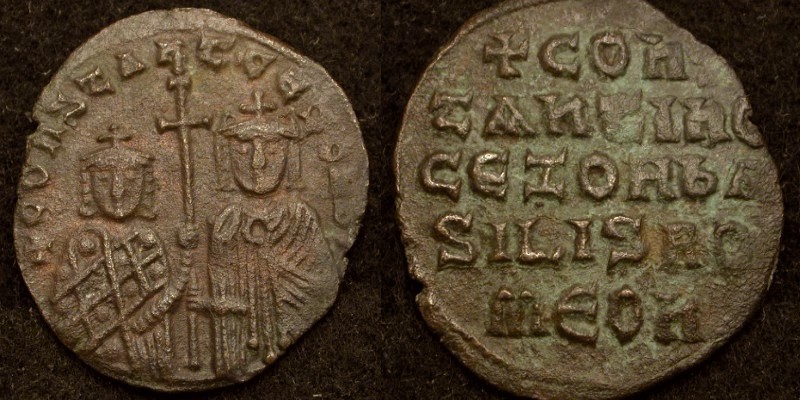 Constantine VII and Zoe. 914-919. Note Zoe is larger.
Constantine VII and Zoe. 914-919. Note Zoe is larger.
26-23 mm. 4.90 grams.
You can see the name "Zoe" as "ZOH" in the obverse legend (at 2:00-3:00) and the middle line of the reverse ("H" is "eta" in Greek).
Obverse Legend: + COҺSTAҺT CЄ ZOH b
Reverse: +COҺS/TAҺTIҺO/CЄ ZOH bA/SILIS RO/MЄOҺ
"Constantine and Zoe, rulers of the Romans"
Sear 1758.
DOC Constnatine VII, 22 "914-919" ("Class 1")
At first the army had some successes under Zoe's generals, but a woman could not lead armies and invasions by the Bulgarians made it clear an able military man was required. The admiral Romanus I pushed himself into the role of regent and co-emperor in 920, forcing out Zoe. He issued coins in his own name (the second type above), having relegated Constantine VII to a minor role. In 921 Romanus promoted his oldest son, Christopher, who was already an adult military man, to co-emperor. Constantine VII was moved down the list of heirs. The next coin, a silver miliaresion, has the names of Romanus I, Christopher, and Constantine VII, in that order, which explicitly shows Constantine VII was not even next in line after Romanus.
Miliaresion. 25 mm. 2.81 grams. Thin. Struck 921-931.
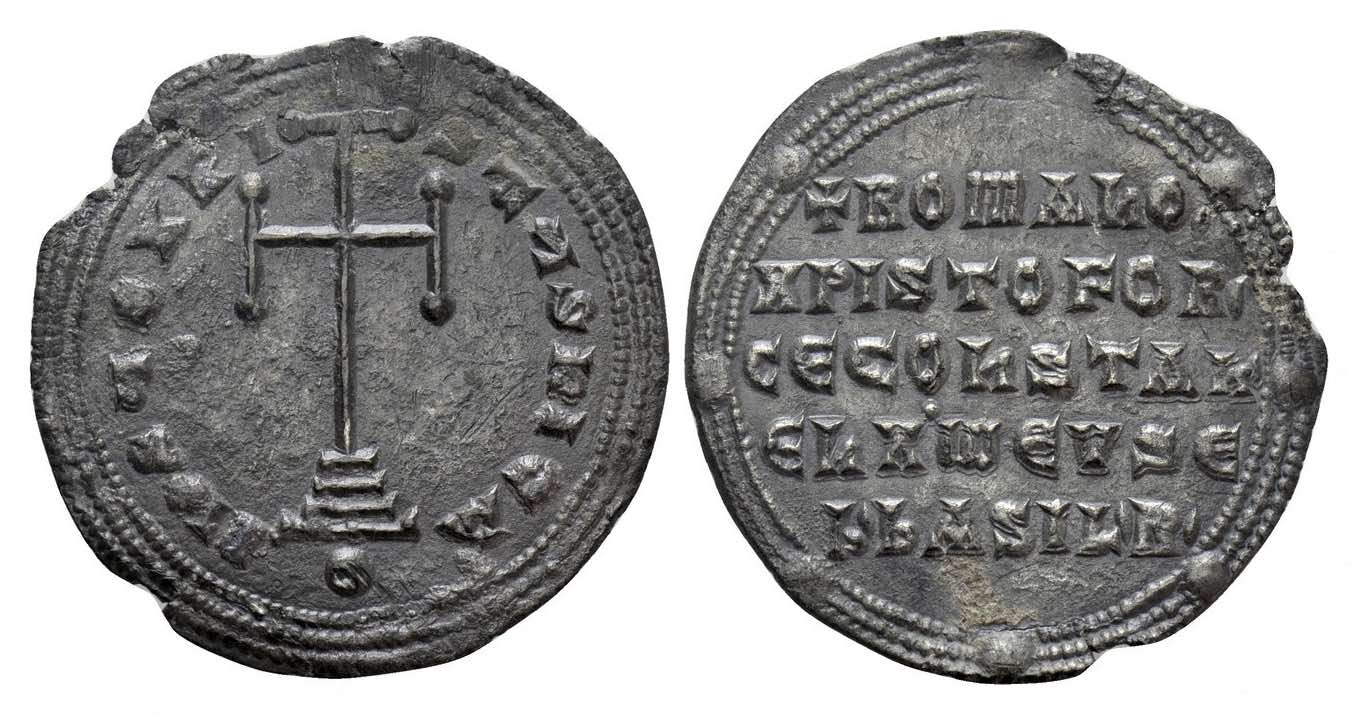 Obverse: Cross potent on four steps, globus beneath.
Obverse: Cross potent on four steps, globus beneath.
IhSЧS XRI-STЧS ҺICA (Jesus Christ conquers)
Reverse:
+ROmAҺO Romanus [and]
XPISTOFOR' Christopher
CЄ COҺSTAҺ' and Constan[tine VII]
ЄҺ Xω ЄVSЄ in Christ, pius [pious]
b BASIL R' emperor of the Romans
Sear 1754.
The name "Christopher" has two R's in it and this coin uses two different letter forms. The first is "P", the Greek Rho, and the second is "R", as in Latin and English.
Then in 924 Romanus promoted his other two sons too. However, Christopher died in 931 and Romanus became despondent, seeming not to care for his other two sons, and eventually wrote a will that would have given the empire (back) to Constantine VII. (In that highly religious age he may have felt that death of Christopher was God's punishment for pushing the rightful emperor Constantine aside.) There are silver miliaresia of that period:
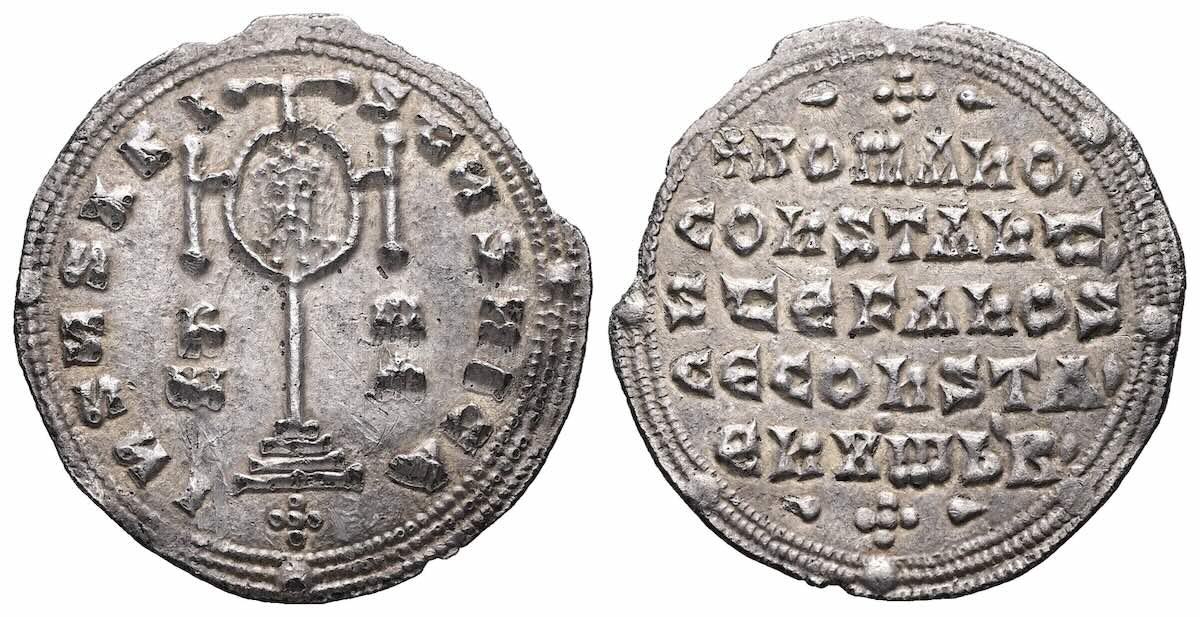 Constantine VII with Romanus the primary emperor
Constantine VII with Romanus the primary emperor
23.5 mm. 2.49 grams. Thin.
Struck 931-944, after Christopher died.
+ROMANO
CONSTANT
STEFANOS
CEVCONSTA'
ENXWbB'
(Romans and Constantine [VII] and Stephan [oldest surviving son of Romanus] and Constantine [Lecapernus, youngest son of Romanus]) in Christ emperors.
There are no copper coins mentioning these two sons of Romanus I.
The two sons of Romanus did not like the idea that they would not inherit the empire. The rightful emperor Constantine VII had been sidelined for decades and they thought they hardly needed to consider him. In December 944 they conspired and overthrew Romanus, forcing him to take vows and join a monastery. However, only a month later the populace backed Constantine VII and overthrew the sons and forced them to join their father. (There are no coins attributed to that month.) Finally, Constantine VII was able to rule in his own right. Finally, he was able to issue his very common type (at the top of the page).
So, you can understand that it was time to call in the coins of Romanus I and restrike them as coins of Constantine VII, which explains the overstrike on the coin above. That type was issued from 945 to c. 950, when Constantine VII began to issue coins with his own son, Romanus II. (The wife of Constantine VII was the daughter of Romanus I.)
 Constantine VII and Romanus II, c. 950-959 [This type was struck until Constantine VII died (of natural causes) and Romanus II became sole emperor at age 21.]
Constantine VII and Romanus II, c. 950-959 [This type was struck until Constantine VII died (of natural causes) and Romanus II became sole emperor at age 21.]
27-25 mm. 7.68 grams.
+COҺST CЄ ROMAҺ b ROM
Their facing busts.
"Constantine [VII] and Romanus [II] rulers of the Romans"
+COҺST'/CЄ ROMAҺ/ЄҺ XRIST/b ROMЄO
"Constantine and Romanus, in Christ, rulers of the Romans"
Sear 1762 under Constantine VII.
DOC Constantine VII, 27 "c. 950-959" ("Class 6")
This type has the only depiction of Romanus II on copper coins. It is very difficult to find an example where the "portrait" of Romanus II is not garbled.
Romanus II was the father of the future emperors Basil II, the Bulgar Slayer, and his co-ruler, Constantine VIII, but he died at age 25 in 963 and his widow married Nicephorus II who pushed the very young children of Romanus II aside and reigned from 963 until he was murdered in 969 by John I. John I died without heirs in 976, so the throne reverted to the sons of Romanus II (who, by then, were 19 and 18).
 Another example.
Another example.
Constantine VII and Romanus II
Struck c. 950-959
26 mm. 5.13 grams.
+CONST CЄ ROMAҺ b ROM
Their facing busts.
"Constantine [VII] and Romanus [II] rulers of the Romans"
+CONST'/CЄ ROMAҺ/ЄҺ XRIST/b ROMЄO
"Constantine and Romanus, in Christ, rulers of the Romans"
Sear 1762 under Constantine VII.
DOC Constantine VII, 27 "c. 950-959" ("Class 6")
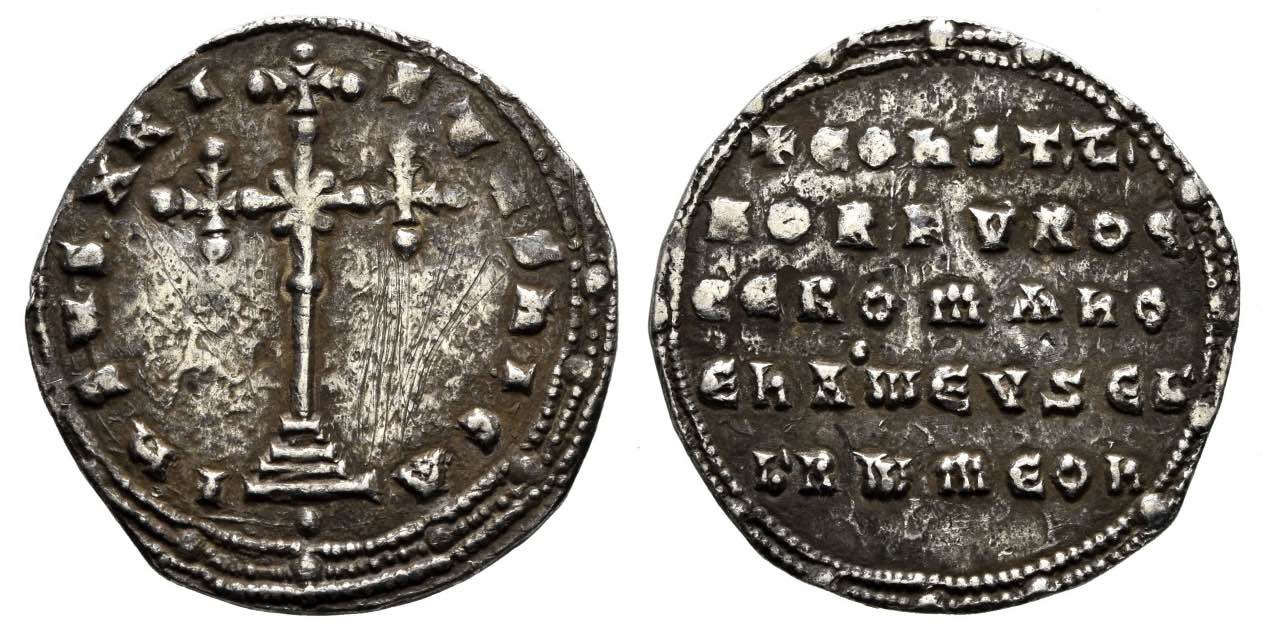 Constantine VII and Romanus II, struck c. 950-959
22 mm. 2.28 grams. Silver miliaresion.
Constantine VII and Romanus II, struck c. 950-959
22 mm. 2.28 grams. Silver miliaresion.
Elaborate cross on four steps
IhSUS XRI-STVS NICA around.
("Jesus Christ conquers")
5-line legend:
+COҺST'T' Constantine
ΠORFVROΓ' Porphyrogenitus (born in the purple)
CЄ ROMAҺO and Romanus [II]
ЄҺ XW ЄVSЄb' in Christ pious
b' ROMЄOҺ emperor of the Romans
Sear 1757.
Actually, Constantine VII did issue one rare copper type before Romanus came on the scene. It follows the type with Constantine and Zoe and precedes the type with Romanus alone.
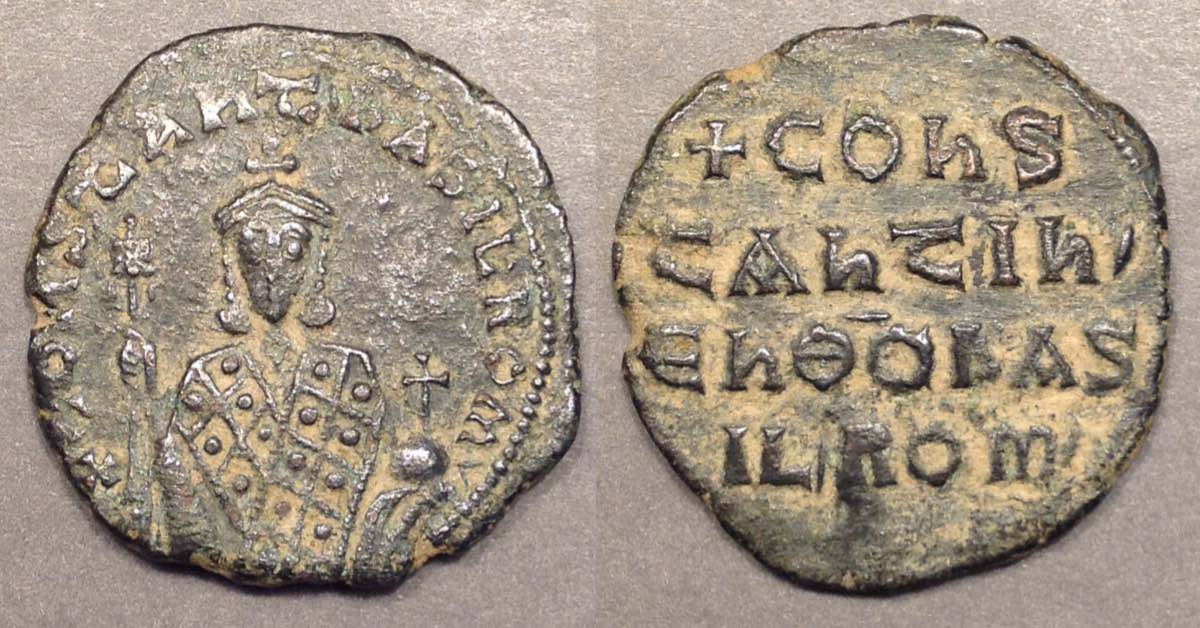 Constantine VII, 913-959
Constantine VII, 913-959
Struck 920-931
26-25 mm. 7.19 grams.
Facing bust with labarum and globus cruciger.
+COҺSTAҺT bASIL ROM
Four-line reverse legend:
+COҺS/TAҺTIҺ'/ ЄҺ ΘO bAS/ILROM'
This type is superficially similar to the common Constantine VII type at the top, but he holds a labarum, not an akakia with his arm across his chest, and the legends are different.
Sear 1759.
DOC Constantine VII 23 "920-931" ("Class 2")
Note for collectors. Byzantine copper coins may not be beautiful. They may not be high grade. But they have great stories! If you don't find the above story interesting, I don't think you will like Byzantine copper coins.
The sequence of events.
Date. Event. (Link to a coin)
913) Constantine VII, son of emperor Leo VI, came to the throne at age 8 after Leo's brother Alexander had ruled for a year. Of course, Constantine was too young so he had regents. After a year his mother Zoe became primary regent (Coin).
920) A military man, Romanus I, forced Zoe out and was proclaimed co-emperor (Coin).
921) Romanus promoted his own adult son Christopher (Coin) as heir over Constantine VII. Constantine VII, while still nominally emperor, was moved down the list of those in line to rule.
924) Romanus promoted his other two sons.
931) Christopher died, which profoundly depressed Romanus
before 943) Romanus wrote a will that would give the empire (back) to Constantine VII.
944) The other two sons of Romanus, left out of the will, revoted and overthrew him, sending him to a monestary.
944) Constantine VII and the populace immediately (in one month) overthrew them, sending them to a monestary too, which made Constantine VII sole ruler. New coins are overstruck (Coin) on coins of Romanus (Coin).
950) Constantine VII issued coins with his own son, Romanus II, as co-ruler (Coin).
959) Constantine VII died of natural causes and Romanus II became emperor. (He only lasted 3 years and did not issue copper portrait coins.)
The End
Return to "Introduction to Byzantine Coins."
A page about reading Byzantine-coin legends.
Go to the Table of Contents of this educational site on ancient coins.
 Constantine VII, 913-959
Constantine VII, 913-959 Romanus I, 920-944, during the reign of Constantine VII (913-959), but with no mention of Constantine VII. Struck 931-944.
Romanus I, 920-944, during the reign of Constantine VII (913-959), but with no mention of Constantine VII. Struck 931-944. This coin: 27 mm. 6.14 grams.
This coin: 27 mm. 6.14 grams. Constantine VII and Zoe. 914-919. Note Zoe is larger.
Constantine VII and Zoe. 914-919. Note Zoe is larger. Obverse: Cross potent on four steps, globus beneath.
Obverse: Cross potent on four steps, globus beneath. Constantine VII with Romanus the primary emperor
Constantine VII with Romanus the primary emperor Constantine VII and Romanus II, c. 950-959 [This type was struck until Constantine VII died (of natural causes) and Romanus II became sole emperor at age 21.]
Constantine VII and Romanus II, c. 950-959 [This type was struck until Constantine VII died (of natural causes) and Romanus II became sole emperor at age 21.] Another example.
Another example. Constantine VII and Romanus II, struck c. 950-959
Constantine VII and Romanus II, struck c. 950-959  Constantine VII, 913-959
Constantine VII, 913-959